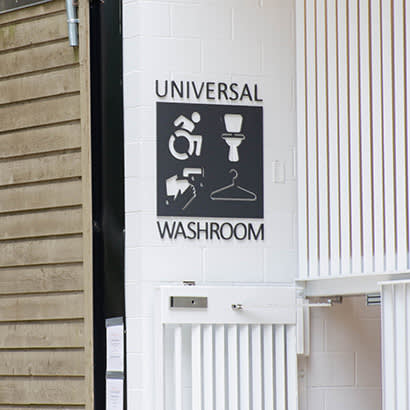
For an enhanced digital experience, read this story in the ezine.
Societal awareness and active advocacy for equity and inclusion within public settings has significantly increased during the past few years, and for good reason. If operators of public recreation-based facilities have not addressed equity and inclusion — specifically regarding transgender populations — as it applies to the accessibility, use and enjoyment of their respective facilities, they should not stick their head in the sand. Whether it be a member, patron or even an employee, it is critically important to be prepared before it is too late. If mishandled, your organization’s image could be tainted or, even worse, you may find yourself in court with today’s litigative environment.
The keys to success in making sure facilities are inclusive and universally accessible for all populations are illustrated below.
Policy Development
Agencies should embark on developing comprehensive policies and procedures with clear expectations for both the public and employees. Policy content should include a statement against discrimination, proper terminology, an explanation of who complaints are reported to and how they are handled, and the rights permitted to transgender individuals. Make sure each policy is vetted by legal counsel, as many state laws vary and change often.
Facility Assessments
Many public facility operators have older, antiquated buildings that were not designed with transgender populations in mind. First-generation adaptations were initially made with diaper stations in men’s washrooms and the initiation of family locker rooms. It is critically important to conduct a full-facilities assessment for equity and inclusion. Key areas to focus on are washrooms, locker rooms and signage. Individual stalls, showers and washrooms are ideal because they create a gender neutral and private space for all people. When these are not available, it is suggested to adapt signage to create a “privacy area” or ensure that signage and policies are supportive of an individual being able to use the facility they most identify with.
Appointment of an Equity Officer
Just like the Americans with Disabilities Act, the Freedom of Information Act or the Open Meetings Act describe, agencies should appoint a person in the organization who is responsible for ensuring equity and inclusion not only through facility accessibility, but also through policies. This can simply be part of a job description. The key is for this individual to have extensive training, preferred human resources experience and access to corporate legal counsel. This person’s main duty is to support staff when equity issues arise and to assist with potential complex, sensitive and, many times, emotional situations that revolve around equity and inclusion. For example, if a transgender individual were to be singled out or harassed for using the locker room that aligns with their gender identity, this staff member would become the primary resource for resolving the conflict and should be able to cite specific inclusive policies the organization has adopted to support their course of action.
Staff Training
Dealing with civil rights and privacy concerns requires careful, deliberate and consistent protocol. In many cases, this must be balanced between approaching these matters on a case-by-case basis and addressing specific or extraordinary circumstances. Many public operators also hire younger staff to cover operations and locker rooms. Lack of experience responding to complex and sensitive situations can be a recipe for disaster.
Thus, training on the terms, definitions, misconceptions, unconscious bias, human rights and situational awareness and de-escalation is critical and requires an agency-wide training program. Awareness, sensitivity and overcoming prejudice toward transgender populations are all key components to staff training initiatives.
Communications, Registration Forms, Data Collection
Park and recreation professionals have a responsibility to ensure that all people, including transgender people, are respected and have access to the amenities, services and environments afforded to dominant groups. Except for facilities that are purely drop-in, most require a membership, registration or some confirmation of participation at the facility. This process is a great way to be proactive with all people about your agency’s policies and commitment to be a welcoming and all-inclusive facility. Written and verbal communications, registration forms and other data collection tools should consider all individuals and the diverse identities and experiences that exist within the community.
Fostering an Inclusive Culture
All of these topics and protocols relate to fostering a universal, welcoming, all-inclusive environment for staff and patrons. This starts with leadership and must become a core value of your organization. In the end, a culture of respect and following the “Golden Rule” is a foundation to successfully implementing an all-inclusive facility.
Learn more about NRPA’s Parks for Inclusion resources.
Michael Clark, CPRP, is Executive Director of Palatine Park District.

